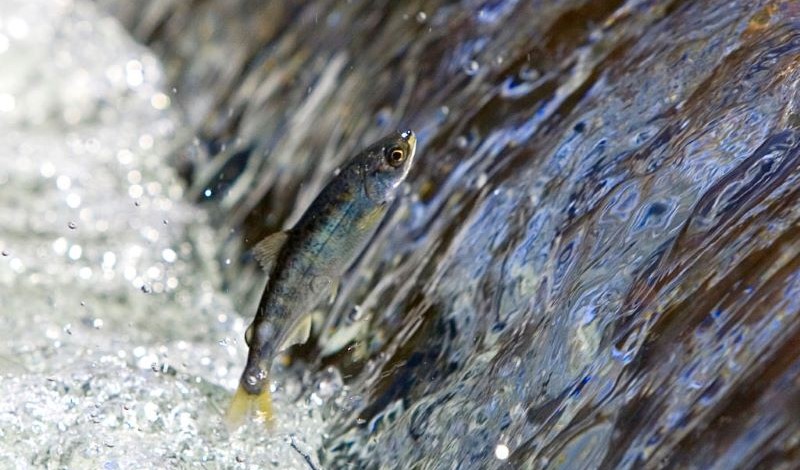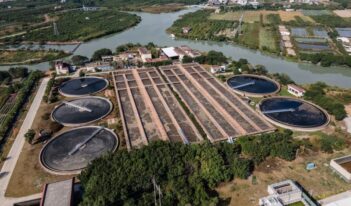
Scholar discusses possible legal avenues to support salmon conservation during climate change.
Pacific Northwest salmon—the region’s most iconic marine animal—significantly impacts the region’s economy, ecology, and culture. But climate change, coupled with hydroelectric and water policies, threatens to eradicate salmon populations.
In a recent article, law professor Michael C. Blumm shows how several bodies of law can help shield Pacific Northwest salmon from worsening climate change.
He explains that increased carbon dioxide absorption in water bodies and surface water interaction with a hotter atmosphere increases overall water temperature. In warmer water, salmon decrease in size and become more vulnerable to disease.
In addition, warm-water predators—such as the northern pike and smallmouth bass—begin to occupy salmon habitats as water temperatures increase. Climate change also depletes salmon prey because warmer water contains fewer nutrients to support prey, and increased carbon dioxide levels in water physiologically degrades foundational species in the food chain.
Streams are not just getting warmer, but are also increasing in water quantity from increased precipitation—in turn altering stream flow. And outside of the water, blistering wildfires in the western United States burn through protective vegetation and increase sediment runoff into streams.
To help conserve salmon populations amid climate change, the law could reform dam operations, public water rights, and other practices that contribute to habitat degradation, explains Blumm.
Dams pose predominantly two problems for salmon populations. Dams alter habitats by rerouting waterbodies, consequently manipulating upstream and downstream habitats. Moreover, dams increase water temperatures because they pool water and slow stream velocity, further exacerbating increased water temperatures already caused by climate change.
The Northwest Power Act authorizes an interstate agency to mitigate adverse consequences of hydroelectric infrastructure, including dams, on Pacific Northwest salmon populations, but Blumm explains that the agency has focused more on “habitat restoration and hatchery production” than restructuring hydroelectric operations. But hatcheries, Blumm notes, are not a fair compromise between hydroelectric power and salmon conversation, as people once thought. Hatcheries deteriorate salmon genetic diversity and interfere with broader food chain dynamics.
Despite dams’ destructive effects on salmon, hydroelectric agencies in Oregon and Washington have not yet adjusted dam operations in light of dam-caused increased water temperatures.
One way to achieve cooler water temperatures and lessen dams’ harms to salmon populations would be through the Clean Water Act (CWA), Blumm explains. Under the CWA, states can create plans that decrease water temperatures. Although regional agencies and dam operators have failed to consider water temperature, Blumm contends that citizens are starting to bring more CWA lawsuits on behalf of salmon. He forecasts that a CWA citizen lawsuit may soon require the U.S. Environmental Protection Agency to regulate, pursuant to its CWA authority, lower water temperatures in the Northwest. Requiring lower water temperatures would cause dam operators to adjust their operations.
The Endangered Species Act and the National Environmental Policy Act are other available laws that could reshape dam operations, according to Blumm. He recounts that courts have required operators under these laws to open dam spillways more frequently, allowing for increased migration of endangered salmon but reduced power generation. He also posits that a non-environmental law, the Federal Power Act, could prompt removal of Northwest dams that do not contain passageways for federally protected salmon.
In addition to dam reform, Blumm advances a legal concept called the “public trust doctrine,” arguing that it should require states to ensure public access to salmon fishing. Generally speaking, resources held in the public trust must be preserved for the public’s use. For instance, states should maintain public access to drinking and recreational waterbodies.
But states in the Pacific Northwest have different approaches to the public trust doctrine.
Alaska’s constitution, for instance, grants the public a right to fish, catch wildlife, and consume water resources. The California Supreme Court has ruled that water is a public resource, and legislation has extended this right to fish, explains Blumm. He maintains that Alaska and California’s water and fish protections can empower their state courts to extend public trust protections to more vigorous salmon conservation. Blumm clarifies, though, that not all states in the Pacific Northwest have such robust protections for public resources.
He explains that Oregon holds fewer resources in public trust, and the state has affirmatively disclaimed responsibility to protect wildlife. Likewise, Washington courts have not declared open access to water as within the public trust.
Although states’ approaches to the public trust doctrine are variable, Blumm contends that federal courts should declare certain resources as protected under a federal public trust. Blumm asserts that federal sovereignty concepts and judicial precedent provides federal courts a path to protecting salmon. But like the states, federal courts are also conflicted on how broadly to protect resources under the public trust, Blumm acknowledges.
Given the Pacific Northwest’s patchwork of public trust protections, Blumm urges regulatory agencies to strengthen existing protections for salmon. The logging industry, for example, cannot log within a certain distance of waterways to preserve water quality. Yet, Oregon’s “buffer zone” regulations are less strict than Washington’s buffer zones, Blumm explains. The relative laxity of the buffer zones in Oregon results in decreased water quality near logging sites, which in turn hurts salmon populations.
Blumm also encourages regulations that support increased fishing of salmon’s non-native predators. For instance, regional agencies pay anglers if they catch large northern pike. They also prohibit salmon fishing during warmer months to reduce stress on salmon populations.
Salmon protection can also occur through international cooperation. Blumm recommends that the U.S. Congress amend the Pacific Salmon Treaty Act—a law that domestically implements a treaty with Canada. Amending the treaty would decrease excessive irrigation and preserve stream habitats in the United States, Blumm argues. But he concedes that Congress is likely unwilling to incorporate a remediation plan into the Act.
Overall, Blumm’s account of international solutions—in addition to his assessment of domestic regulatory, common law, and statutory solutions—shows how various legal sources could be used to conserve the economically and culturally valued Northwest Pacific salmon.



